
The Lamu Space Station is a nomadic and interactive initiative, centered in community artivism, from which different reflections and actions contribute to promote a more harmonious relationship with the environment. When we imagine local futures, we want to use local materials and local artisans. For instance, we worked with a Masai craftsman named Jackson to develop the Lamu goggles.
Thadde Tewa interviews the developers of the futuristic installation: Lamu Space Station
Lamu Space Station | Courtesy of Earth Force Climate Command (EFCC)
The Lamu Space Station
Interview with Ajax Axe, Abdul Kipruto, Lincoln Mwangi and Anna Mokeira
After a successful launch of the Aspen Space Station last year, Ajax Axe, a US-born multi-disciplinary artist teamed up with a group of Kenyan artists and nonprofit organizations to launch the first Lamu space station in Shela, Lamu, an island in the Indian Ocean off the northern coast of Kenya, which is also part of the Lamu Archipelago.

Lamu Space Station | Courtesy of Earth Force Climate Command (EFCC)
The Lamu Space Station, which officially launched on 22nd January this year through 20th March, is an interactive earth focused initiative and a futuristic installation concept that responds directly or challenges a modern space fantasy narrative about the future, or rather the ‘race to space’ frenzy, propagated by 21st century billionaires like Elon Musk and Jeff Bezos.
“The presumption that we can deplete all of the resources on Earth and escape to another planet is delusional at best and extremely dangerous.” says their mission statement, available on their website; https://www.thefutureisonearth.org/lamu
Through Earth Force Climate Command (EFCC), a network of established and emerging artists, activists, design thinkers and local organizations around the world, Ajax, the Director and Founder, is helping to prototype and implement community visions and solutions for the future. Pushing everyone directly or indirectly involved to not only imagine new and more sustainable stories about the future but also encourage billionaires and more organizations to join the initiative; which encourages the human race, to stay on earth, enjoy it and to stop thinking we can torch this earth and then escape to another one.
“Even before arriving here, I had heard of Lamu as a beautiful place with no cars, which intrigued me a lot.” says Ajax, who first arrived in Lamu in 2010 while on vacation from a National Geographic research project in Sudan, and she has lived there on and off since then.
“I later on fell in love with the local design sensibility and the local materials being used for furniture, building and clothing. Unlike most places today, Lamu still had a unique sense of place; globalization hadn’t erased its identity. And the island, the problems with ocean pollution and our proximity to Somalia and the challenges there have all influenced my work and my thinking about the future.” She continues to narrate to me as we start off our long-awaited phone call conversation together with Abdul Kipruto, Lincoln Mwangi and Anna Mokeira who are also part of the Lamu space station team. Enjoy!
Interview with Ajax Axe, Abdul Kipruto, Lincoln Mwangi and Anna Mokeira on the Lamu Space Station
TT: First and foremost, congratulations to all of you on the successful launch of the Lamu space station, and above all the previous achievements in environmental work and activism. Ajax, tell us, what inspired the Lamu space station idea?
AA: The idea came up in 2021 while working with woven baskets as prototypes for making pod structures as an alternative design solution for refugee housing in Dadaab, Garissa County; and I happened to mention to friends how they look like space pods from the fantasy of how mars would look like and the architectural structures of space in the developing narrative that is the space station and it spiraled from there.
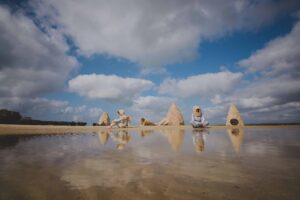
Lamu Space Station | Courtesy of Earth Force Climate Command (EFCC)
TT: Very interesting, tell us more about your initiative, Earth Force Climate Command (EFCC), when it was founded and its objective?
AA: At a moment when Mars is being promoted as a sexy alternative to Earth, I’m encouraging the human race to join hands and work as a global team to protect and appreciate our home planet. I founded Earth Force Climate Command (EFCC) in 2021, a network of established and emerging artists, activists, design thinkers and local organizations around the world who are helping to prototype and implement community visions and solutions for the future. Using local materials, artists, artisans and design practices means that each EFCC initiative will be unique and representative of its specific location on Earth.

Lamu Space Station | Courtesy of Earth Force Climate Command (EFCC)
TT: That’s such a noble cause, please explain to us why you chose Shela for the Space Station and not Lamu town, more so in an abandoned building?
AA: The Location, Shela, Lamu, was the least of concern, I was more interested to have a space to actually transform. Originally, I wanted to set up the installation at an abandoned old cotton ginnery that is between Shela and Lamu town but it was costly to rent, also it would have been too much work to clean; to make the space usable again and then the factory entrance could only be accessible during low tidings. The next location available was this private house, seemingly abandoned, which the owners gave me the go ahead to make necessary changes to fit the concept. There is something beautiful about using abandoned spaces because no one really cares what you do with it. This allowed us to have full creative control to transform the space towards the concept.
Just as the artist statement on our site says, Lamu then became the ideal location to package the concept of outer space and its purity of culture as it still remains rich individually even with the evolution of time, giving it a new narrative. The project is rooted on the basis of transforming a space to fit the inspiration of seemingly opposite concepts that bring out the technique of an exquisite corpse.
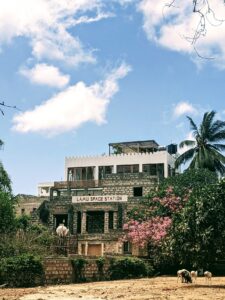
Lamu Space Station | Courtesy of Earth Force Climate Command (EFCC)
TT: From the images and videos you shared, the Lamu Space Station installation seems to possess a captivating artistic flow and high level of authenticity in regards to the stories and the choice of media. I must say the imagination and creativity behind the project is incredible! Kindly tell us more about the creative process, use of locally found materials as media, and any piece (s) that you were directly involved in creating.
AA: The Space station is a space fantasy narrative that challenges the fantasy perspective of the future that is constantly being fed to the collective consciousness by the western media. With the understanding that not one piece of human architecture actually exists in outer space; and that the visuals usually seen in Hollywood films are merely fictional work of artists. The space station challenges the fantasy of futuristic architectural structures that we imagine should exist in space by creating the futuristic structures here on earth using locally available materials from the community.
Just like the space station project we did in Aspen, the Lamu space station’s futuristic mission and program is embedded in community arts activism and engagement. The exhibition and installation are built inside an abandoned house. We transformed the rooms into displays of Paintings, Sculptures and three-dimensional installations, including Ornamental pillar installation by Abdul Kipruto, Lamu pods by me and Onesmus Mangi, Time and Space installation by Lincoln Mwangi and Anna Mokeira’s self – portrait triptych and many more.
I’ll share more about Lamu pods created by me with Onesmus Mangi. In 2799 people live in Earth pods where they can enjoy sun and light as they live close to the natural world. They experience the beauty of Lamu which they know is better than Mars because they went to Mars and it was so horrible, they have sworn never to speak of it again.
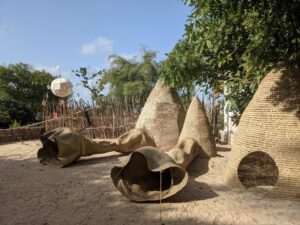
Lamu Space Station | Courtesy of Earth Force Climate Command (EFCC)
Choice of media
The space station is a nomadic and interactive initiative, centered in community artivism, from which different reflections and actions contribute to promote a more harmonious relationship with the environment. When we imagine local futures, we want to use local materials and local artisans. For instance, we worked with a Masai craftsman named Jackson to develop the Lamu goggles.
We worked on a research, prototype, and implement model for designing new ideas. Riffing on the space fantasy, we wanted to develop new headgear for our future in Lamu with a nod to Space Helmets. We designed numerous different prototypes of the Lamu helmet using palm leaf fibre. We also maximized on locally found materials we collected, like plastic disposed of in the ocean including cigarette lighters, plastic slippers, construction pipes, diving flippers and many more.
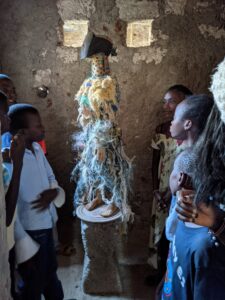
Lamu Space Station | Courtesy of Earth Force Climate Command (EFCC)
TT: Out of curiosity, Ajax, discuss the opening reception, with focus on the local community response towards the Lamu Space Station initiative. From my understanding most of the Lamu locals are quite conservative and I’m imagining it would have taken some more time for them to trust you and the team or even convince them about such a futuristic concept, totally different from the norm?
AA: I must say, I was quite nervous because of the conservative values of the Lamu community but I do think I did establish a rapport and goodwill with the community since I have lived in Lamu on and off for 12 years. I had already had ties with almost all the members of the village. I also found a space where whoever wanted to participate had the liberty to, without imposing on the community with this ‘strange’ concept. I did get opinions from locals who told us that we did a great job and genuinely had a positive response. The actual way to know the feedback is from people’s spontaneous responses.
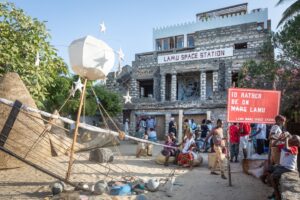
Lamu Space Station | Courtesy of Earth Force Climate Command (EFCC)
TT: Another question about the launch or opening reception, and it’s open to all of you, how many people attended and interacted with the installation during the launch, and what do you think the audience saw as opposed to what you, the artists, wanted them to see?
AA: The opening had approximately 150 guests (a mixture of artists, locals, tourists) of which all of them truly were like little children because of the distinct transformation of the space. The challenge was to make the audience see the future from where we are on earth rather than; the thought of escaping or building a totally different environment. This is what is done at the Space Station with the use of local materials.
LM: Also, artists play a huge role in the reflection of what is happening around them and what could potentially happen in the future. The space station gives a narrative to the community of not only what happens in their community but what also happens outside community principles.
TT: Back to you Ajax, it’s amazing to see familiar names and faces in the project. How did you meet Lincoln Mwangi and Abdul Kipruto, and tell me how this collaboration made sense to team up with artists from Nairobi who are definitely involved with totally different media and practice, Also, did you feel in any way, the environment of the artist would contribute positively to the execution of the concept?
AA: I met Abdul first coincidentally with a mutual friend of ours. My friend and I were going to Wildebeeste, Lamu where I was interested in working with the print press and Abdul happened to be the one who opened the door! I explained to him the concept later on and he was interested in collaborating. After facing and moving past the covid restrictions, the project was up and running again and he was still down to work on it. With Lincoln, I met him later and Abdul had suggested bringing him along since they both already had been involved in other projects in Luma and had created a relationship with the community. Initially, I only wanted to work with local artists but at some point, shifted to the interest of working with artists from Nairobi who had a more formal practice; and Abdul and Lincoln fit just right to execute this concept and I felt more confident because of their previous experience in Lamu.
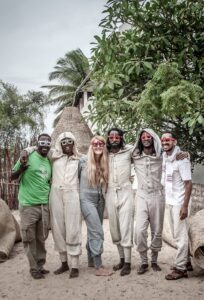
Lamu Space Station | Courtesy of Earth Force Climate Command (EFCC)
TT: Abdul, what brought you to Lamu, was there a particular reason or need to shift from your usual studio routine and environment in Nairobi to explore different media and experience. Also, is this why you would be interested in being a part of the Lamu Space Station?
AK: The project came at a time when I had decided to change location as an artist from Nairobi to Lamu to explore a fresh creation process for my practice therefore it happened to be convenient to have a project to do while in my stay in Lamu.
TT: From your social media, you happened to have a printmaking workshop at Wildebeeste and now you’ve collaborated on an installation, is it possible that you could be shifting media as an artist, and also do you think the Lamu Space Station gave you a challenge to shift media or is it just a one-time concept of exploration in your practice?
AK: The Lamu space station has surely challenged me to shift to an exploration in my own practice. But I have always been interested in working on a thematic creation so the project came in time for me to shift to that thought. Also, the opportunity came up for me to finally collaborate with Ajax and in a different environment such as Lamu. After working on this project, it is difficult to go back to a usual routine because of its enriching capacity, thus it would obviously open a new dimension of the creation process in my practice.
TT: In what ways do you think the Lamu Space Station experience will impact your studio practice or future independent projects?
AK: The project involved the use of local materials which perhaps does not apply in my work. It’s given me the inspiration to use more local media in my practice.
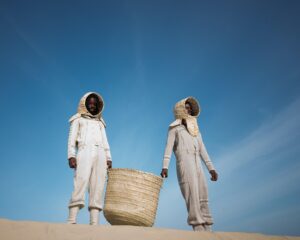
Lamu Space Station | Courtesy of Earth Force Climate Command (EFCC)
TT: Discuss your role (s) in the Lamu Space Station creative process, and also any piece (s) you contributed to the project?
AK: The project did have a form of structure around it but I focused more on the art production process and the art I had to do.
I’ll discuss my Ornamental pillar installation. The idea was conceived while visiting Manda Island near Lamu. I considered how the island was a metaphor for civilization. It has a beautiful facade that faces the channel that most people see while the other side is covered in trash that washes up on the beach from the Indian Ocean. We often hide the ugliness of consumerism behind a thin veneer of beauty.
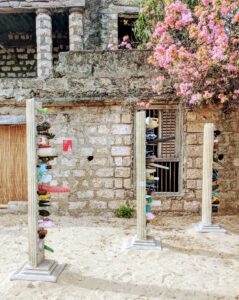
Lamu Space Station | Courtesy of Earth Force Climate Command (EFCC)
TT: Lincoln, what inspired you to join the Lamu Space Station initiative because I’ve known you as a more traditional media artist?
LM: I think as artists, experience helps with the progression of thoughts, so working on Lamu space station was a no brainer. Also, my practice now is expression of narratives of cosmic elements which heavily coincides with the thematic element of the project; and being in Lamu drills in the involvement of nature. The use of mirrors and weighing scale in my piece was an element I had wished to explore; thus, the project was an opportunity to align my creation thoughts and borrow ideas from the use of everyday material to express a narrative.
TT: How was the experience of shifting in media and environment as an artist?
LM: The project itself is rooted on the concept of individuals adapting to different environments making the phrase ‘I am an alien’ quite relevant. Being an artist from Nairobi and working in Lamu, there was a perspective of learning to understand factors that affect the foreign place and adapt to a different culture and way of expression of the new environment that one happens to find themselves in.
TT: Discuss your role (s) in the Lamu Space Station creative process, and also any piece (s) you contributed to the project?
LM: The whole project was certainly a cohesive creation process that had a common vision and each of us was free to do exactly what pleased one making it a comfortable environment to express creatively. This was possible because we had a clear plan that involved everyone.
I’ll share more about my installation Time and Space. It explores the relationship between the imagined and real life of objects we consume. We think of something as gone, we throw it away but it actually continues to exist in some form and symbolizes a time and place where it was used. It takes a new meaning as it travels further from its place of intended use.

Lamu Space Station | Courtesy of Earth Force Climate Command (EFCC)
TT: Very impressive line of thought! I must acknowledge that it’s inspiring to see artists from Nairobi exploring a different form of expression far from the norm that is seen in the Nairobi contemporary art scene. It feels as though sometimes such concepts can be controversial or perhaps too fresh that it might rock the scene; would you say there is a chance for more Kenyan artists to explore such fields too?
LM: Why not? Artists need to first have a vision of the means they wish to express and then work actively on it rather than passively then execute the vision once the opportunity arises.
TT: Anna, how does it feel to be in such a fantastic project such as Lamu Space Station, and also is it something that you expected as an artist?
AM: I definitely did not expect this, I thought it was a crazy idea but thanks to Ajax we made it happen. She encouraged me a lot to keep going because at the time I was feeling a bit down but with encouragement, support and patience I was able to be part of its completion. I did not think I would be able to complete it after not being able to do my usual practice of canvas and acrylics for about 4 months.
TT: Happy for you Anna! Please tell us how you came to know about Ajax and her initiative, and also do you think you’ll stop painting traditionally after this experience?
AM: I will definitely continue painting! Working with artists from Nairobi definitely inspired me to think of more ideas and gave me a form of character development especially working with older artists. I got to know about Ajax through Nyambura, who introduced me to her when I went to visit Nyambura at her Shela home. I talked to Ajax and she told me about the project. I was fascinated then just like that I was hooked to collaborate.
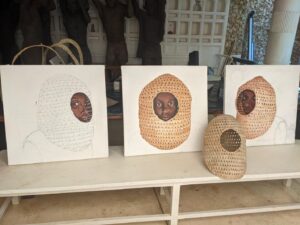
Lamu Space Station | Courtesy of Earth Force Climate Command (EFCC)
TT: To wrap up the dialogue, what do you guys have to say as closing remarks or are there any pieces of advice that you would love to tell an artist interested in installation work?
AA: I have two things to say: One, focus on something that you feel excited about and drawn to because it will draw an audience organically. Two, there is power in working collaboratively with other artists as it opens one to take risks and makes one less vulnerable to fear of failure.
AK: As an artist, growing your knowledge of things and skills extensively, installations become smoother for you as it is expressed conceptually. As you explore an installation it sharpens you, making you move to a more unconventional form of art which focuses more on putting across a message which will always be new.
LM: When an opportunity arises for you to actualize your installation concept, do not hesitate to take it and execute it to existence.
AM: When collaborating with other artists in installations, it is good to believe in them, you never really know what could possibly be in their mind even if you try. Learn to be patient all the way.
Thadde Tewa – TT, Ajax Axe – AA, Abdul Kipruto – AK, Lincoln Mwangi – LM, Anna Mokeira – AM
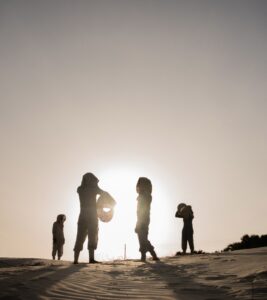
Lamu Space Station | Courtesy of Earth Force Climate Command (EFCC)
